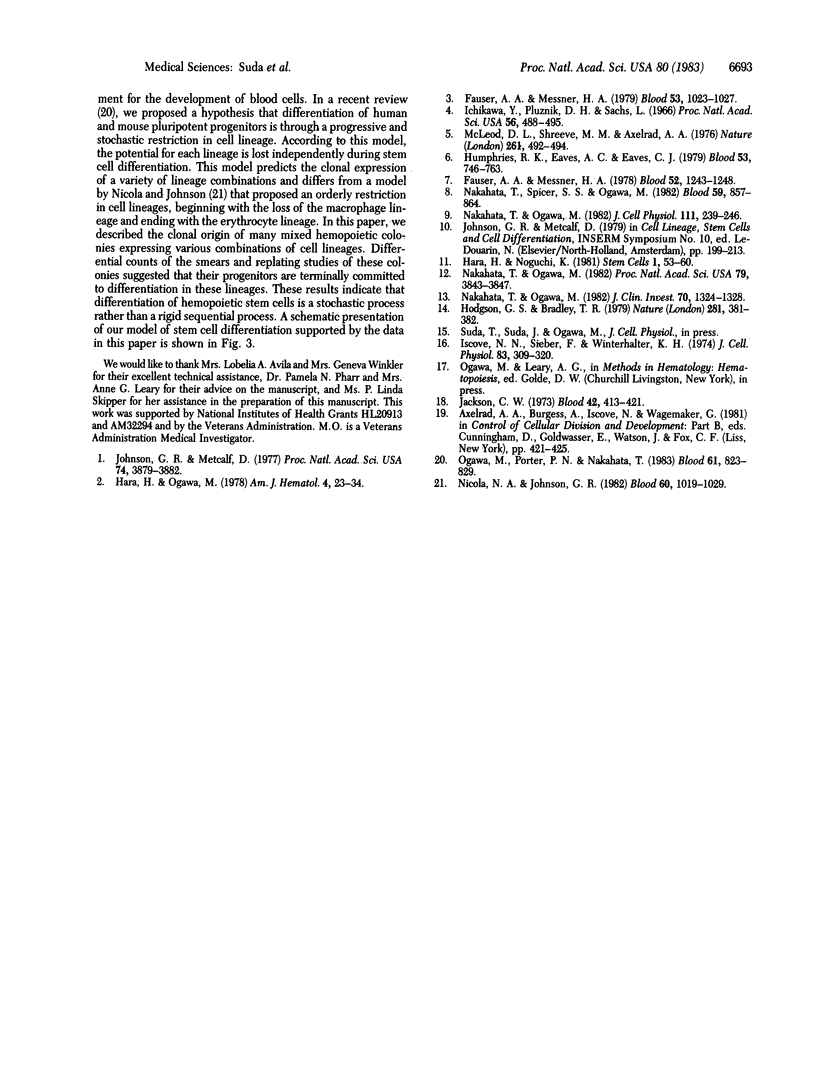Abstract
By using a micromanipulator, single cells from blast cell colonies were individually transferred to 35-mm culture dishes for secondary colony formation. When individual colonies appeared to be mature, they were examined for cellular composition by May-Grunwald-Giemsa staining and were replated for determination of unexpressed hemopoietic potentials. We describe here a total of 50 mixed hemopoietic colonies. Seven types of colonies consisting of cells in two different lineages were seen--i.e., neutrophil-macrophage, neutrophil-eosinophil, macrophage-eosinophil, macrophage-mast cell, macrophage-megakaryocyte, macrophage-erythrocyte, and erythrocyte-megakaryocyte. Six types of colonies revealed three cell lineages--i.e., neutrophil-macrophage-eosinophil, neutrophil-macrophage-mast cell, neutrophil-macrophage-erythrocyte, macrophage-mast cell-erythrocyte, neutrophil-macrophage-megakaryocyte, and neutrophil-erythrocyte-megakaryocyte lineages. In addition, multilineage colonies expressing terminal differentiation in varying combinations of more than three lineages were present. Replating studies confirmed that the progenitors for many of these colonies are terminally committed to differentiation only in the lineages disclosed by staining. This study, thus, provides a proof for the single-cell origin of mouse hemopoietic colonies expressing various combinations of cell lineages. It also supports the hypothesis that the differentiation of multipotential hemopoietic progenitors is through progressive and stochastic restriction in cell lineages.
Full text
PDF




Images in this article
Selected References
These references are in PubMed. This may not be the complete list of references from this article.
- Fauser A. A., Messner H. A. Granuloerythropoietic colonies in human bone marrow, peripheral blood, and cord blood. Blood. 1978 Dec;52(6):1243–1248. [PubMed] [Google Scholar]
- Fauser A. A., Messner H. A. Identification of megakaryocytes, macrophages, and eosinophils in colonies of human bone marrow containing neurtophilic granulocytes and erythroblasts. Blood. 1979 May;53(5):1023–1027. [PubMed] [Google Scholar]
- Hara H., Noguchi K. Clonal nature of pluripotent hemopoietic precursors in vitro (CFU-mix). Stem Cells. 1981;1(1):53–60. [PubMed] [Google Scholar]
- Hara H., Ogawa M. Murine hemopoietic colonies in culture containing normoblasts, macrophages, and megakaryocytes. Am J Hematol. 1978;4(1):23–34. doi: 10.1002/ajh.2830040105. [DOI] [PubMed] [Google Scholar]
- Hodgson G. S., Bradley T. R. Properties of haematopoietic stem cells surviving 5-fluorouracil treatment: evidence for a pre-CFU-S cell? Nature. 1979 Oct 4;281(5730):381–382. doi: 10.1038/281381a0. [DOI] [PubMed] [Google Scholar]
- Humphries R. K., Eaves A. C., Eaves C. J. Characterization of a primitive erythropoietic progenitor found in mouse marrow before and after several weeks in culture. Blood. 1979 Apr;53(4):746–763. [PubMed] [Google Scholar]
- Ichikawa Y., Pluznik D. H., Sachs L. In vitro control of the development of macrophage and granulocyte colonies. Proc Natl Acad Sci U S A. 1966 Aug;56(2):488–495. doi: 10.1073/pnas.56.2.488. [DOI] [PMC free article] [PubMed] [Google Scholar]
- Iscove N. N., Sieber F., Winterhalter K. H. Erythroid colony formation in cultures of mouse and human bone marrow: analysis of the requirement for erythropoietin by gel filtration and affinity chromatography on agarose-concanavalin A. J Cell Physiol. 1974 Apr;83(2):309–320. doi: 10.1002/jcp.1040830218. [DOI] [PubMed] [Google Scholar]
- Jackson C. W. Cholinesterase as a possible marker for early cells of the megakaryocytic series. Blood. 1973 Sep;42(3):413–421. [PubMed] [Google Scholar]
- Johnson G. R., Metcalf D. Pure and mixed erythroid colony formation in vitro stimulated by spleen conditioned medium with no detectable erythropoietin. Proc Natl Acad Sci U S A. 1977 Sep;74(9):3879–3882. doi: 10.1073/pnas.74.9.3879. [DOI] [PMC free article] [PubMed] [Google Scholar]
- McLeod D. L., Shreve M. M., Axelrad A. A. Induction of megakaryocyte colonies with platelet formation in vitro. Nature. 1976 Jun 10;261(5560):492–494. doi: 10.1038/261492a0. [DOI] [PubMed] [Google Scholar]
- Nakahata T., Ogawa M. Clonal origin of murine hemopoietic colonies with apparent restriction to granuclocyte-macrophage-megakaryocyte (GMM) differentiation. J Cell Physiol. 1982 Jun;111(3):239–246. doi: 10.1002/jcp.1041110304. [DOI] [PubMed] [Google Scholar]
- Nakahata T., Ogawa M. Hemopoietic colony-forming cells in umbilical cord blood with extensive capability to generate mono- and multipotential hemopoietic progenitors. J Clin Invest. 1982 Dec;70(6):1324–1328. doi: 10.1172/JCI110734. [DOI] [PMC free article] [PubMed] [Google Scholar]
- Nakahata T., Ogawa M. Identification in culture of a class of hemopoietic colony-forming units with extensive capability to self-renew and generate multipotential hemopoietic colonies. Proc Natl Acad Sci U S A. 1982 Jun;79(12):3843–3847. doi: 10.1073/pnas.79.12.3843. [DOI] [PMC free article] [PubMed] [Google Scholar]
- Nakahata T., Spicer S. S., Ogawa M. Clonal origin of human erythro-eosinophilic colonies in culture. Blood. 1982 Apr;59(4):857–864. [PubMed] [Google Scholar]
- Nicola N. A., Johnson G. R. The production of committed hemopoietic colony-forming cells from multipotential precursor cells in vitro. Blood. 1982 Oct;60(4):1019–1029. [PubMed] [Google Scholar]
- Ogawa M., Porter P. N., Nakahata T. Renewal and commitment to differentiation of hemopoietic stem cells (an interpretive review). Blood. 1983 May;61(5):823–829. [PubMed] [Google Scholar]



